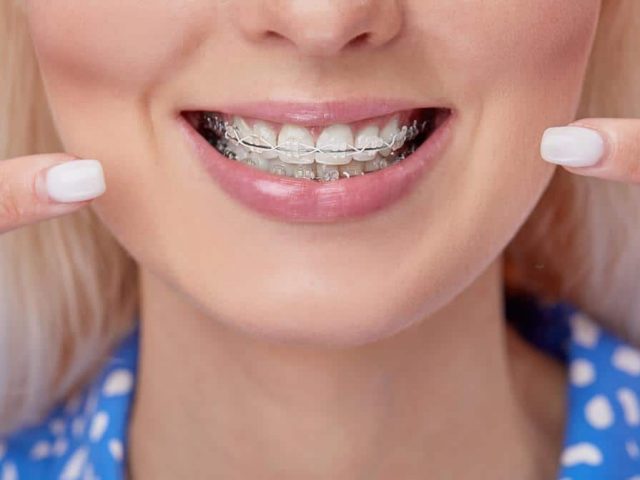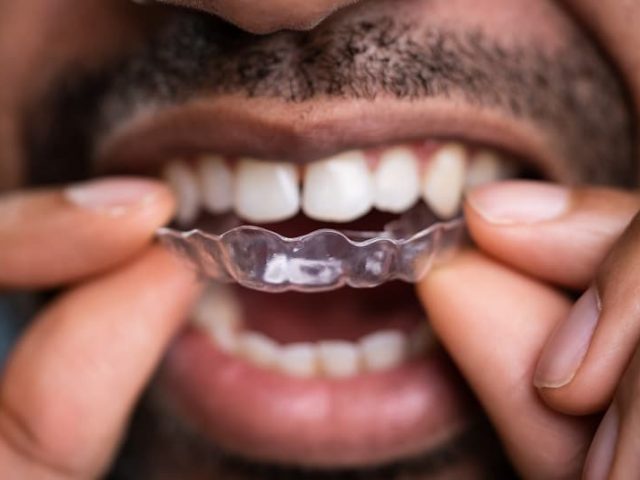Clear Braces Vs. Invisalign: The Pros and Cons

When it comes to straightening teeth, there are a few different options available. Clear braces and Invisalign are two of the most popular. So, which one is right for you? In this article, we will discuss the pros and cons of each option so that you can make the best decision for your needs!
What Exactly Are Clear Braces?
Braces are one of those things that you probably don’t think much about you or someone you know has to get them. Then, all of a sudden, there are so many things you realize you didn’t know about them. Fortunately, we’re here to provide some answers to your burning questions about braces – specifically, clear braces.
Clear braces are made from a ceramic material that blends in with your natural tooth color. That means they are much less noticeable than metal braces, which can be a big plus if you’re a self-conscious teenager or an adult who doesn’t want to draw attention to your orthodontics treatment.
Clear braces work just like traditional metal braces, using brackets and wires to gradually move your teeth into the correct position. The main difference is that they are less visible, which can make the whole experience more acceptable for people who are worried about how they will look with metal braces and can be a great option in your treatment plan. Let’s weigh the pros and cons of each option, Invisalign and clear braces, both designed to move teeth and ensure a positive outcome.
The Pros of Clear Braces
Now that we know a little bit more, let’s take a look at some of the pros and cons of clear braces.
- Clear braces are less visible than standard braces. The ceramic material is a white shade and very similar in color to enamel which makes them match your teeth more closely and blend in compared to the stainless steel, metallic look of traditional braces.
- Clear braces are made from stain-resistant material. That means you don’t have to worry about your braces getting discolored if you eat or drink something colored.
- Clear braces, like traditional braces, are very effective at straightening even the most crooked teeth.
The Cons of Clear Braces
Now that we’ve discussed some of the pros, let’s discuss the cons.
- Clear braces are brittle. Because they are made from ceramic, clear braces are more likely to chip, crack or break if you accidentally hit them or bite on something hard.
- Similar to metal braces, clear braces can also cause irritation and poke your cheeks and gums.
- Ceramic braces are usually 10-20% bigger than metal braces. So while they are less visible, they are larger and potentially more uncomfortable.
Let’s move on to Invisalign.
What Exactly is Invisalign?
Invisalign is a clear plastic aligner that fits over your teeth. It uses a series of custom-made aligners to gradually move your teeth into place, optimally into the desired position. Invisalign is virtually invisible, which means people will barely be able to tell that you’re wearing them! Invisalign is different from braces in a few key ways that we’ll discuss.
The Pros of Invisalign
Invisalign is removable. That means you can take them out to eat, brush, and floss your teeth.
- Invisalign is practically invisible. Because the aligners are clear, people will barely be able to tell that you’re wearing them!
- Invisalign does not require any special cleaning products or modified hygiene routines. You can just brush and floss your teeth like normal.
- Invisalign is more comfortable than braces. Since Invisalign doesn’t use brackets or wires, the irritation and poking from braces aren’t an issue.
- Invisalign has about 50% fewer in-office visits as compared to braces.
- Invisalign typically costs less than braces.

The Cons of Invisalign
- Invisalign can be lost or broken. Because aligners are removable, they can be misplaced or accidentally thrown away requiring a new set of aligners.
- Invisalign must be removed prior to eating and must be put back in after eating. Sometimes people forget to put their clear aligners back in after eating and this can reduce the effectiveness of the treatment.
- Invisalign, while removable, needs to be worn for 22 hours a day. That can be a challenge for people who have busy schedules or are forgetful.
- There are a few situations in which a person may not be a candidate for Invisalign. This includes situations where there is severe crowding of the teeth, canine impactions, and some jaw surgeries.
How Do I Make the Decision Between Clear Braces and Invisalign?
There are many things to consider when you’re trying to decide between clear braces and Invisalign and your dentist may not be able to answer these questions. One of the most important factors is your personality. If you can wear the aligners consistently as per your orthodontist’s recommendations, then you should have no trouble with Invisalign. However, if you are the type of person that finds it extremely difficult to stick to routines, then braces may be a better option for you compared to Invisalign.
Most cosmetic cases that can be treated with braces can also be treated equally as well in Invisalign which is why so many adults are now seeking orthodontic treatment. But if your teeth are extremely crooked or you have stuck (impacted teeth) or need jaw surgery, then your orthodontist may decide that braces are a better option to help you achieve your desired result.
Another thing to keep in mind is your budget. Invisalign tends to be more cost-effective than clear braces, although the exact cost will vary depending on your specific situation and type of orthodontic treatment.
Ultimately, the best way to figure out which treatment is right for you is to consult with an orthodontist who can assess your individual needs and recommend the best course of action.
Other Things To Be Aware Of
When you’re considering clear braces or Invisalign, there are a few other things to keep in mind. First, treatment with either option will take some time. Generally, you can expect to wear braces or Invisalign aligners for at least 12-18 months, although more complex cases may take longer.
It’s also important to be aware that you’ll need to see your orthodontist for regular office visits and check-ups throughout treatment so they can monitor your progress and make any necessary adjustments. With braces, you will need twice as many checkups as Invisalign to achieve the same result. If you are a candidate for Invisalign, it can be a very cost-effective and time-effective option for orthodontic treatment.
Finally, you’ll need to be diligent about taking care of your teeth during treatment. This means good dental hygiene, such as brushing and flossing regularly, avoiding hard and sticky foods, and being careful not to damage your braces or aligners.
Final Thoughts
Both clear braces and Invisalign are effective treatments for straightening misaligned teeth, but they each have their own pros and cons that you’ll need to consider before making a decision and understanding the differences between the two. Ultimately, the best way to figure out which treatment is right for you is to consult with a qualified orthodontist in Calgary who can assess your individual needs and recommend the best course of action. Either way, with a little bit of care and patience, you can achieve the straight, healthy smile you’ve always dreamed of. Our Invisalign patients understand choosing the type of treatment, often between clear braces vs Invisalign is a personal choice and one that we are most happy to help with.
